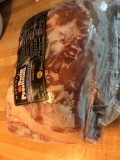Pulled Pork - Deep South
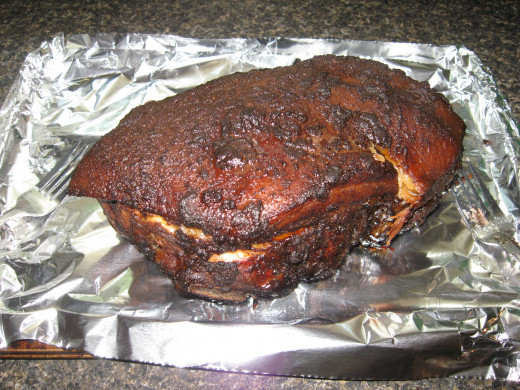
Deep South
The Deep South is steeped in time-honored traditions, and one of them is BBQ and pulled pork. And what a delicious tradition it is! Wait…I might be getting ahead of myself here. Do you know where the Deep South is? It’s the southeastern part of the United States. The specific states are often debated, but the ones most often included are Georgia, Alabama, South Carolina, Louisiana, and Mississippi. Northern Florida and eastern sections of Texas are usually included, too. A broader description of the Deep South might also include North Carolina, Tennessee, and Arkansas. The Deep South isn’t just a geographical location, though. It’s a way of life, rich in history and customs, with its own unique vernacular. Cooking and sharing meals is an important tradition that’s often handed down from generation to generation. Celebrations often center around food, and cooking is often a group effort. Oftentimes, such is the case with BBQ and pulled pork.
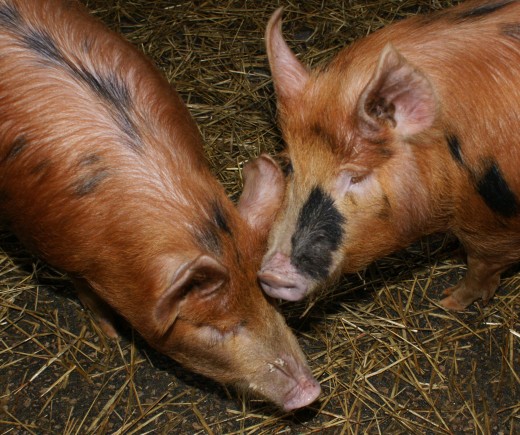
BBQ
The Deep South is famous for its BBQ…or barbecue…or barbeque…or bar b q. Why are there so many different spellings for such a simple term? Whatever you want to call it, barbecue in the South is almost a religion. Even a small southern town like mine has numerous BBQ restaurants, and if they’re good, they stay packed with happy customers. Allow me to clarify: I’m talking about barbecue in the Deep South, not the South, as a whole. In Texas, barbeque often means beef brisket, and in Tennessee, bar b q might mean pork ribs. Travel east from Texas, and south from Tennessee, and you’ll find that barbecue almost always means pork shoulder. And when you think of pulled pork and pulled pork sandwiches, barbecue usually means smoked pork shoulder, or smoked pork butt.
We eat other types of BBQ down here, but we don’t call it just BBQ. When we grill chicken and slather it with a spicy sauce, we call it barbecue chicken or barbecued chicken. Pork chops cooked in the same manner are called barbecued pork chops. The simple term of BBQ by itself means pork barbecue that’s been chopped or shredded and usually combined with BBQ sauce. Most of us didn’t actually start calling the dish pulled pork until the last couple of decades. Before then, it was just BBQ.
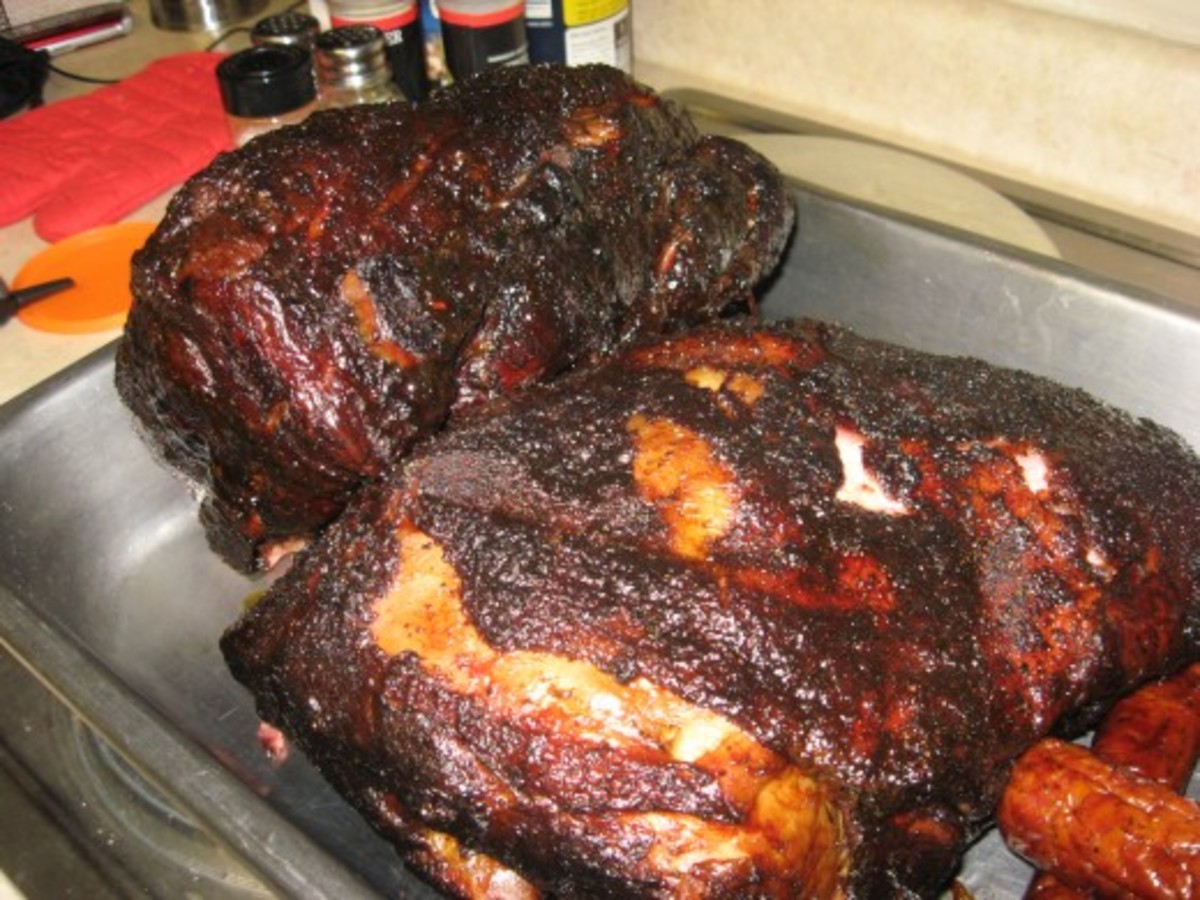
Pork Shoulder
Pork is almost always the meat of choice for BBQ in the Deep South. It’s one of our many southern traditions. This affinity for pork probably dates back to when so many southerners were poor and living sort of a hand-to-mouth existence. Most folks couldn’t afford to keep cattle. They didn’t have enough land for grazing, so they kept pigs, instead. The pigs didn’t have to graze, and they’d eat just about anything. Porkers could be kept in the woods, where they’d survive eating roots, acorns, and whatever else they could find. In fall, when the weather got cold enough, the pigs would be butchered. Friends and neighbors would often help each other with the process. One hog was often selected to cook on hog-killing day to feed everyone, and the barbecue was born.
Whole hogs or pigs are still turned into BBQ sometimes, but unless you’re feeding a really big crowd, that’s way too much meat to have at one time. A more manageable hunk of meat is a pork shoulder, and that’s usually the preferred cut for pulled pork.
Pork shoulder is just what it sounds like – it’s the right or left shoulder of a pig. When you buy one at the supermarket, the front leg isn’t usually attached. The shoulder is usually divided into two cuts: the blade shoulder and the arm shoulder. The arm shoulder is the lower part of the shoulder, and in some cases, a portion of the front leg might still be attached. The blade shoulder is the top part of the pork shoulder. It’s usually called the butt or Boston butt.
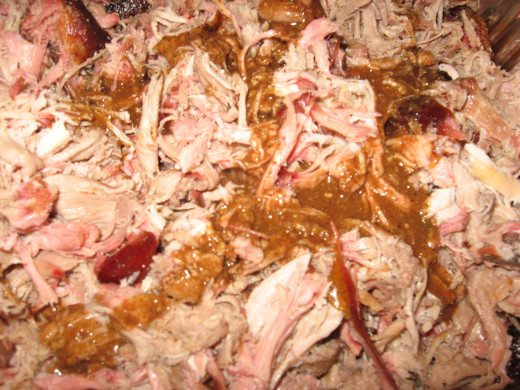
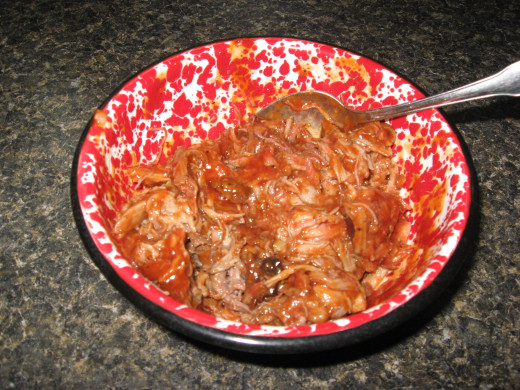
Pork Butt
The term pork butt is somewhat of a misnomer. It sounds like a pork butt would come from a pig’s hindquarters, right? Nope! The butt, often called Boston butt, comes from the pork shoulder. A Boston butt is the end, or butt, of the shoulder roast. Which brings up another point. Why is it called a Boston butt? Is Boston famous for smoked pork butt? I don’t think so, at least not in the southern tradition of Deep South barbecue.
A couple of centuries ago, meat packers in the New England states often packed and stored parts of butchered pigs in butt barrels. Butchers in and around Boston often separated pork shoulder in the manner I described above, and the name stuck. The end section was called the pork butt or Boston butt.
A pork butt is a great cut for slow cooking. It’s usually fairly fatty, and all that fat melts and bathes the lean flesh, adding flavor and juiciness. There’s one large bone in a Boston butt – the blade bone. After slow cooking on meat smokers, the bone lifts out easily. Another great thing about a pork butt is that they’re relatively cheap. We can usually find them on sale around here for around $1.69 a pound.
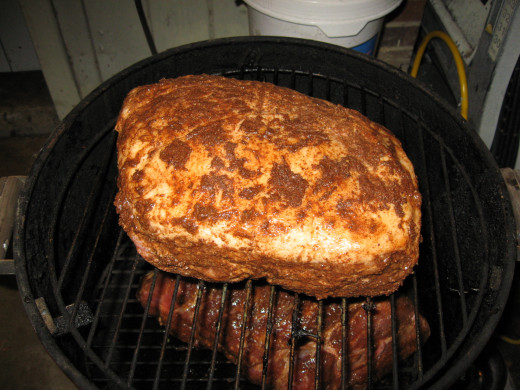
Smoked Pork Butt
When an experienced barbecue cook or grillmaster decides to make smoked pork butt, they take a lot of time with their creation. If the pork butt has a really large fat cap, it’s usually trimmed down some, but it isn’t completely removed. Some outside fat covering ensures a juicy, tender, flavorful pork shoulder. Once the pork shoulder has been trimmed, if needed, a BBQ rub is usually added. The rub can be a wet rub or a dry rub, and it contains salt, spices, and herbs. A wet BBQ rub might also use vinegar, hot sauce, lemon juice, and/or Worcestershire sauce. If the pork is very lean, a little cooking oil might be used in the butt rub, too. From my experience, added oil to a Boston butt is rarely necessary, however. There’s already enough marbling in the flesh and enough exterior fat already present.
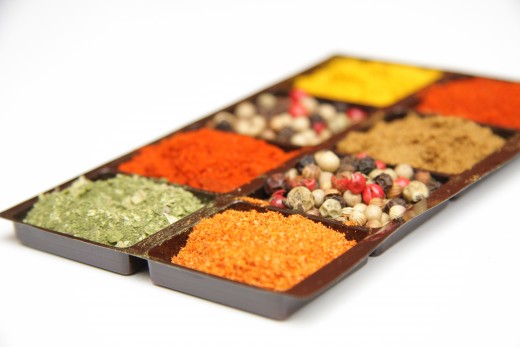
BBQ Rub
A BBQ rub isn’t just sprinkled on the pork butt – it’s called “rub” for a reason. It needs to be rubbed – actually massaged – into the flesh, on the entire outside surface area. Also, I like to be really generous when applying my butt rub. In fact, I think it would hard to use too much BBQ rub on a pork butt. I like to pack on and in as much BBQ rub as the pork shoulder will hold.
There are lots of BBQ rubs available commercially, but most of the southern cooks I know make their own. It’s easy to do. A good BBQ rub usually consists of salt, brown sugar, black pepper, cayenne, and paprika. Other herbs and spices that might be added are chili powder, cumin, ground cloves, cinnamon, dry mustard, ginger, onion powder, garlic powder, and oregano. For a dry rub, no liquids are needed. Wet BBQ rubs usually include some of the dry seasonings I just listed, plus vinegar, prepared mustard, or Worcestershire sauce.
After the meat has been thoroughly seasoned and massaged with the BBQ rub, it needs to be wrapped to hold in all the flavors. Some folks use foil for this, but I prefer using plastic cling wrap. The plastic wrap adheres better to the Boston butt, and it’s more air-tight. Once the meat has been seasoned, massaged, and wrapped, I like to leave the Boston butt in the refrigerator to cure. How long should the pork butt cure in the fridge? We usually leave ours in the fridge for at least twelve hours, but we’ve left them for longer on several occasions, with good results.
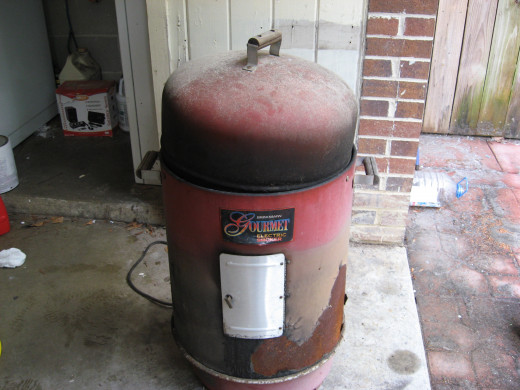
Smokers
People in the Deep South can get pretty creative with smokers. Meat smokers are often made from used refrigerators, which actually works out well. Different cuts of meat can be placed on the shelves for smoking, and the shelves are adjustable. Meat smokers made from old refrigerators will hold a lot of meat. Other smokers might be made of metal barrels or drums. Some are so large that they have to be pulled behind a vehicle, usually a pickup truck.
You’ll also see a lot of smokers in the Deep South made from brick or cinderblock. These are usually called BBQ pits. When we had a farm and raised our own pigs, we did a lot of meat smoking, often on a large scale. We built a pit BBQ smoker from cinderblock, using metal rods and heavy wire screen for the grilling surface.
The term BBQ pit came from using an actual pit for smoking meat. My uncle still uses this method for making pulled pork and other BBQ entrees. He and his pals dig a hole in the ground and place a large piece of tin in the bottom. The dressed pig is laid out on the metal, and coals from a nearby fire are added, as needed. Another piece of tin is placed over the pig and the coals to trap the smoke.
Of course, manufactured smokers are used a lot, too. We’ve used charcoal smokers and electric smokers, and we prefer the electric models for smoking meat. Our favorite unit isn’t large, but it holds plenty of meat for us, even when we’re smoking meat for feeding guests. It has two racks, and each rack can hold two pork butts. By the way, the best electric smokers we’ve found are Brinkman smokers. We’ve been using our present Brinkmann smoker for years!
Brinkmann Smoker:
Brinkmann Electric Smoker:
Smoking Meat
Smoking meat is pretty much an art in the Deep South. The pork butt is chosen carefully, and so is the BBQ rub. A decision about the best BBQ wood is also made. The BBQ wood has a big influence on how the final product tastes. Some human meat smokers prefer different types of cooking woods for different meats. For example, they might prefer mesquite for beef and applewood for chicken. In my opinion, a good all-around BBQ wood is pecan. We’ve used it for beef, chicken, pork, and turkey – all with excellent results.
While the meat is smoking, people often gather around the meat smoker, chatting and enjoying cold beverages. Some cooks use a mop sauce for smoking meat. A mop sauce is usually a thin liquid that’s liberally applied to the meat during the cooking process. It usually has a vinegar base.
Smoking meat is done with low temperatures, usually ranging from 225-250 degrees. Obviously, it takes hours for the meat to cook. An internal thermometer is usually used to decide when the meat is done. Pork shoulder can be safely eaten when it reaches 150 degrees on the inside, but for pulled pork, it needs to cook longer. Most folks like for their smoked pork butt to reach an internal temperature of around 190 degrees, which makes the meat easy to shred. The meat is usually removed from the smoker when the thermometer reaches 180 degrees. The pork butt is then wrapped tightly in foil and allowed to rest at room temperature for 20-30 minutes. At that point, the temperature of the meat will usually rise to around 190.
Once the smoked pork shoulder is done, wrapped, and rested, there are several ways to handle the meat. Some people like their barbecue sliced, some like chopped barbecue, and others prefer pulled pork. If you’re feeding a crowd and you’re smoking more than one pork butt, you can offer guests all three types of barbecue.
If the pork butt has been chopped or shredded, you might want to go ahead and combine it with BBQ sauce before serving it. On the other hand, you might prefer to let your dinner guests each add their own BBQ sauce to the chopped or pulled pork. Some people like the meat plain, with no sauce at all. Sometimes I add a light sauce to my pulled pork. I make the sauce with apple cider vinegar, apple juice, garlic salt, hot sauce, and a little sugar. You might want to try something similar next time you make pulled pork.
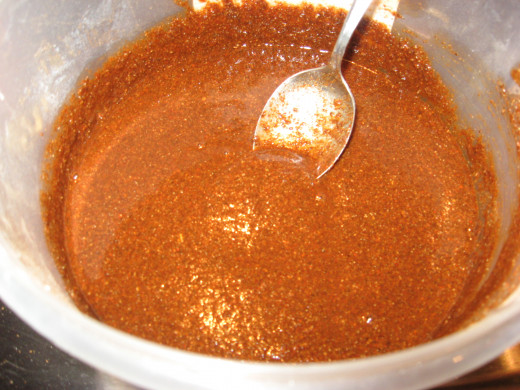
BBQ Sauce
Is the secret really in the BBQ sauce? Well, that’s just one of the “secrets” to pulled pork in the Deep South. I’ve already shared most of the others with you. Many southern cooks pride themselves on their BBQ sauce. Even men who can’t cook at all indoors might have a closely guarded recipe for BBQ sauce that they created themselves.
There’s no right or wrong when it comes to homemade BBQ sauce, and there are tons of variations. Some are sweet, some are hot, some are savory, and some are tangy. A typical base begins with ketchup, tomato sauce, chili sauce, vinegar, or prepared mustard. Added liquids might include lemon juice, lime juice, orange juice, apple juice, pineapple juice, hot sauce, soy sauce, teriyaki sauce, sweet and sour sauce, honey, molasses, maple syrup, cane syrup, soft drinks, Worcestershire sauce, and Liquid Smoke. Melted butter or oil might also be added. Dry BBQ sauce ingredients might include salt, sugar, brown sugar, and/or spices and herbs. Sometimes chopped or pureed fruits or veggies might be added, too, like onions, bell peppers, hot peppers, pineapple, peaches, and raspberries.
It’s easy to make your own homemade BBQ sauce. Just decide what flavors you want to include, and experiment with the mixture until you get the right flavor. If the texture is too chunky, run the sauce through the blender. For a more pronounced flavor and a thicker consistency, simmer your BBQ sauce on the stove before using it.
BBQ Sauce Ingredients:
Liquids
| Dry Seasonings
| Other
|
|---|---|---|
ketchup
| paprika
| chopped onion
|
chili sauce
| cayenne
| chopped bell pepper
|
prepared mustard
| cumin
| pureed peaches
|
vinegar
| salt
| pureed raspberries
|
hot sauce
| black pepper
| pureed blackberries
|
soy sauce
| chili powder
| chopped jalapenos
|
teriyaki sauce
| red curry powder
| chopped chili peppers
|
Worcestershire sauce
| dry mustard
| grated horseradish
|
Coca-Cola
| celery salt
| minced garlic
|
Dr. Pepper
| garlic powder
| orange marmalade
|
bourbon
| onion powder
| pineapple marmalade
|
beer
| sugar
| apple jelly
|
honey
| brown sugar
| apricot jam
|
molasses
| Splenda
| peach jam
|
cane syrup
| seasoned salt
| cherry preserves
|
maple syrup
| oregano
| pepper jelly
|
fruit juice
| chipotle powder
| chopped celery
|
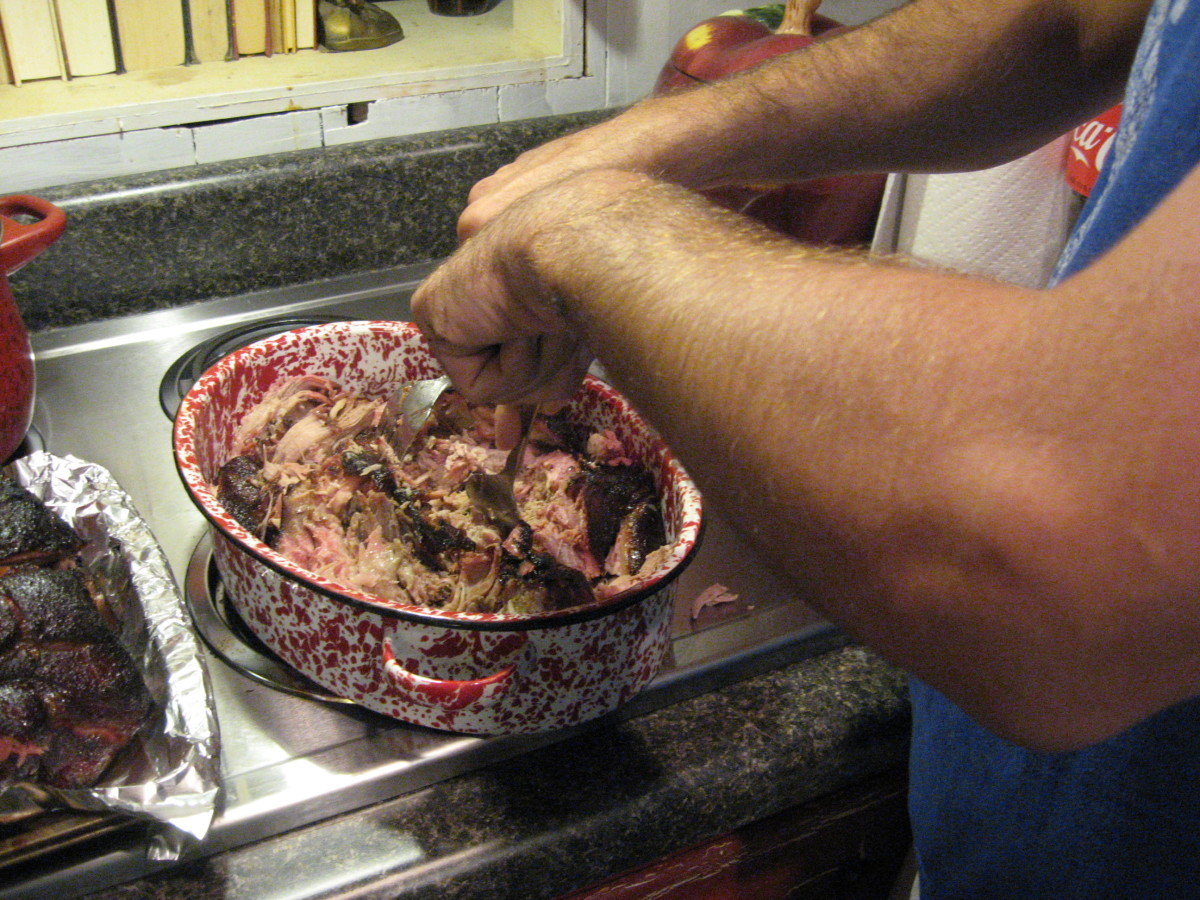
Pulled Pork
I think the term pulled pork is self-explanatory, but I grew up in the Deep South. I’ve had some northern friends who asked me why it’s called pulled pork. It’s because the cooked meat is actually pulled apart. This can be accomplished with a couple of forks, or with special gadgets called bear claws. In my opinion, the pork butt needs to be shredded fairly fine, almost into single muscle fibers. That means more surface area, and more surface area makes the meat able to hold more BBQ sauce.
In almost all cases, pulled pork is made from smoked pork shoulder. Sure, you can use other cuts of pork for pulled pork, but a Boston butt makes the best pulled pork. Ever wonder why that is? It’s because a pork butt is loaded with collagen and marbled with fat. When the pork shoulder is cooked for hours over a low, smoky heat source, these elements break down and turn into juicy, flavorful meat that can be shredded or pulled easily.
Some people like to take the easy way out with a crock pot pulled pork recipe. I’ll admit that I’ve done this myself on occasion, but in all honesty, a slow cooker pulled pork recipe can’t hold a candle to pork that’s been smoked low and slow over BBQ wood - hickory, oak, or my personal favorite, pecan wood. Once you get serious about smoking meat, you’ll probably want to try several different BBQ woods. And yes, there is a difference!
How to Make Pulled Pork:
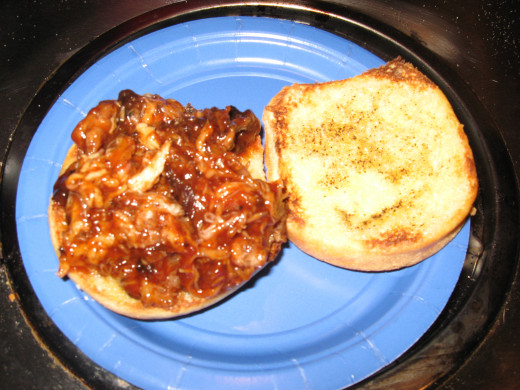
Pulled Pork Sandwiches
For many southern fans of barbecue, the best way to enjoy smoked pork butt is in pulled pork sandwiches. Of course, when it comes to pulled pork sandwiches, practically every southerner has his or her own ideas as to what constitutes the best pulled pork sandwiches. Some people like to eat their pulled pork on plain white bread, while others might prefer hamburger buns. Actually, my preference for pulled pork sandwiches is onion rolls. I like to take a big onion roll, split it and butter it, and toast it before piling on the pulled pork. I like my pulled pork sandwiches with nothing but pulled pork that’s been mixed with barbecue sauce. That brings up yet another point about pulled pork: to add or not to add barbecue sauce to the shredded meat. That’s entirely up to you. Some cooks like to add BBQ sauce directly to their pulled pork, while others prefer to serve the sauce on the side.
And what about other condiments and additions to pulled pork sandwiches? My husband, like many southerners, doesn’t think pulled pork sandwiches are complete without a spoonful of slaw added atop the pulled pork. Others might like to add sliced tomatoes, mayonnaise, dill pickles, onions, or sweet pickles to their pulled pork sandwiches.
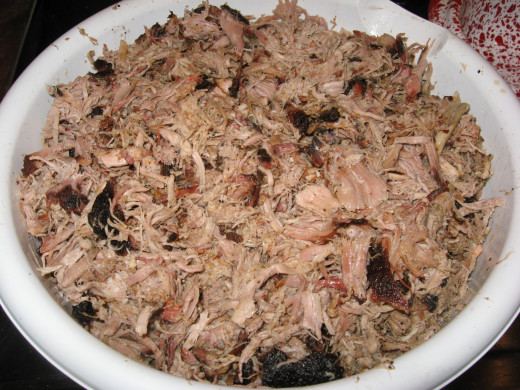
Pulled Pork Recipes
I’m hoping all this talk about BBQ has you craving some smoked pork shoulder! I know I am. I’ve been following a pescatarian diet, so I haven’t eaten any barbeque in weeks. I did, however, just speak with a worker in a local slaughterhouse, and I found out that they follow the Humane Kill guidelines set forth by the USDA. I got a good report from this worker about the handling and slaughter processes used in the plant, so I feel somewhat better about eating pork and beef. Still, I’m not entirely ready to give up my pescatarian diet, depending on what my lab work reveals next week.
For more information about barbecue, in general, click the link in the first paragraph of this article, which takes you to my cooking site. For a great pulled pork recipe, click this link. I also have some pulled pork recipes on Hubpages, including a slow cooker pulled pork recipe. Like I said, slow cooker BBQ isn’t as good as BBQ that’s cooked on smokers, but in a pinch, it makes acceptable pulled pork.
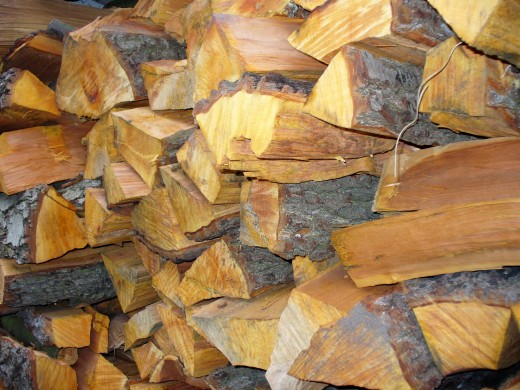
BBQ Restaurants
If you don’t want to go to the trouble of cooking your own pork butt and making your own pulled pork, you can enjoy the dish at a good restaurant. If you’re looking for great BBQ restaurants in the Deep South, don’t judge the barbecue by the building’s exterior. What you want to look for is a big pile of wood somewhere, along with billowing smoke from the smoker. The aroma should fill your nostrils before you ever arrive at the barbecue restaurant’s parking lot. And when you get to the parking lot, read the car tags. If you see lots of local cars, you’re in the right spot. There a few good barbecue restaurants in the South that are chains, including Sonny’s, Hog-n-Bones, Smokey Bones, and Woody’s Bar-B-Q. Don’t just stick to these, however. Find some mom-and-pop BBQ restaurants for a real adventure. Practically every southern town has at least one. Heck, sometimes you can find some awesome barbecue at roadside stands and gas stations! Remember – when you can’t make your own pulled pork and you’re looking for great BBQ restaurants, follow your nose!





